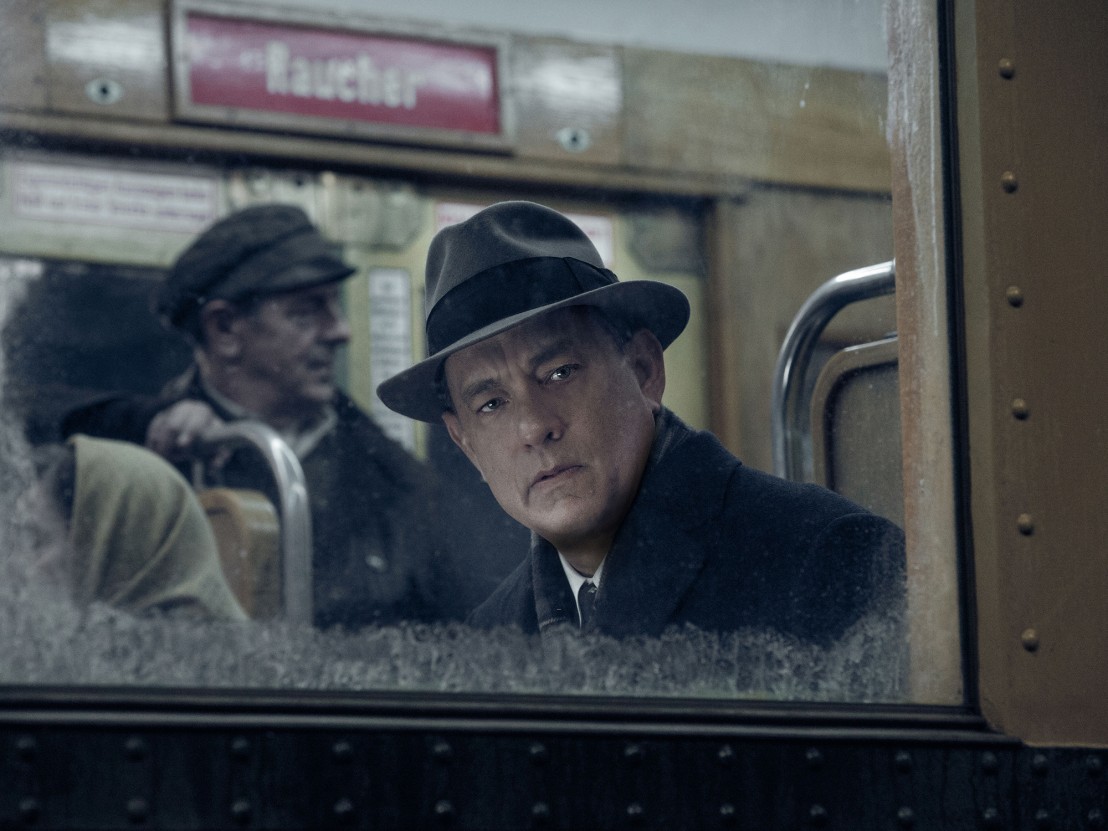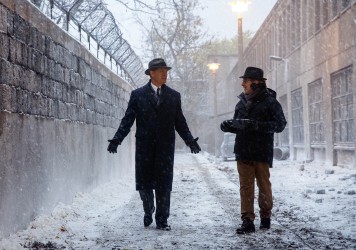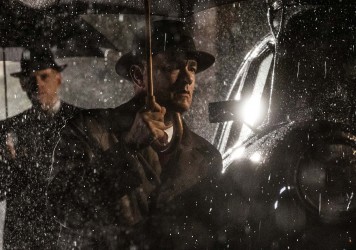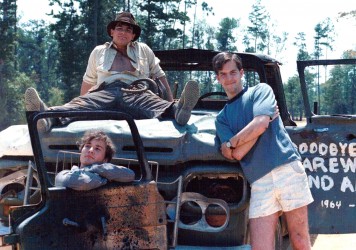
So we’ve covered most of The Beard’s TV work, a couple of his also-ran features and a few sacred cows – now it’s onto the proper business of covering the big ones…
The only horror film officially directed by Spielberg is this made-for-TV corker. While it holds interest as a dry-run for Poltergeist (the most Spielbergian movie not directed by the man himself), it can also lay claim to being the first Spielberg film open to retrospective auteurist readings. From the (mentally, if not physically) absent father to the invaded sanctuary of the home, Something Evil prefigures the director’s fascination with parental anxieties and the dislocating psychological pull of the ‘other’ – be it supernatural, extraterrestrial or simply foreign to the status quo. Eschewing easy scares for a sustained sense of the uncanny, it’s one of Spielberg’s few female-driven films. If the narrative points forward to Poltergeist, its wrecking-ball of maternal guilt finds itself echoed thirty years later in A.I. Matt Thrift
This pilot episode of the Amazing Stories TV series received a kicking from the press when it was first broadcast in September 1985, a shame given that it’s a hauntingly evocative Spielbergian miniature, re-uniting the collaborative dream team of composer, John Williams and DoP, Allen Daviau. Which isn’t to say it’s likely to win the filmmaker any new fans, those allergic to his sensibilities may want to give this one a wide berth. Spielberg crafts a poignant study of guilt and death in just 25 minutes, as a grandfather awaits a Stygian appointment with the spectral incarnation of a train he caused the derailment of as a child. Adopting a child’s eye perspective to fuse a sense of loss to wonder, it’s an elegant distillation of the filmmaker’s stylistic and thematic tropes. MT
No one could ever accuse Spielberg of insincerity. More often than not, it’s exactly his heart-on-sleeve earnestness that detractors point to while running a mile in the opposite direction, many of them as determined to hate on Always as Bon Jovi was determined to love it. It’s certainly an old-fashioned picture, a throwback to the kind of Hollywood classicism that speaks of its genesis as the only remake (granted, War of the Worlds was previously adapted) in the director’s filmography. Contemporising Victor Fleming’s 1943 drama A Guy Named Joe, it retains its predecessor’s Hawksian milieu while fusing old-school melodrama to a spiritual enquiry into the recurrent Spielbergian preoccupations of abandonment and letting go. It’s a poignant, underrated Hollywood fairy tale, and one of the filmmaker’s most existentially yearning works this side of A.I. MT
Returning for some classic comic-strip manna, Spielberg tag-teamed it up with beardy brother-in-arms Peter Jackson for this whiz-bang motion-capture caper which offered a spectacular yet reverential take on Hergé’s hallowed creation – the tenacious boy detective with the skyward quiff and a trusty mutt named Snowy. Okay, so the whole “dead eyes” problem hasn’t been rectified here, but where the film perhaps lacks a little soul, it more than fills in that gap with kinetic set-pieces and a plot which barrels along as fast as an express steam train. It works as an antiquated adventure movie, but within Spielberg’s own back catalogue, it exists as part of a surreal, self-referential double feature with 2008’s Indiana Jones and the Kingdom of the Crystal Skull. David Jenkins
The magnum opus of young Spielberg’s TV years, Duel made such a splash that after debuting on ABC it was extended for an international cinema release. Based on a Richard Matheson story about a Chrysler-driving travelling salesman psychotically stalked by a truck driver, it’s a mechanical Deliverance of man and machine point-of-view shots, replete with overt references to the emasculation of the modern American male. (“You’re the boss.” / “Not in my house, I’m not.”) Challenged to draw feature-length interest simply from varying angles of two men driving, Spielberg shows himself on the precipice of Hitchcockian mastery, but the triumph is one of formal invention – while nerve-shredding on first viewing, it’s more of a construct for study when revisited. Ian Mantgani
The infectious glee with which Spielberg approaches the business of espionage and the Cold War in Bridge of Spies bears all the affections of a childhood spent under their influence. From its understated elegance and tight storytelling through to its fiercely constructed set-pieces, it’s clearly the work of a master filmmaker. On the surface Bridge appears to be a Capra-esque pageant of American values and everyman triumph, but aptly for a spy flick so engaged with questions of false fronts, Spielberg’s often-astonishing editing schemes and visual style suggest a more cynical reading. It’s vanity that leads insurance lawyer Donovan (Tom Hanks) to take on the role of company man for USA Inc, and self-serving arrogance borne out of trial by fickle public opinion that leads him to pursue his twofer exchange and a trip to East Berlin. As we journey with Hanks back to postcard Americana, he’s reminded of the horrors he’s witnessed by some kids scaling a wall, but they’re swiftly forgotten as he clocks his validation in a newspaper. A heroic return, but at what expense? He sleeps easy regardless.
This it the brutal, surly brother to Bridge of Spies’ clean-cut kid, a spy thriller in which characters are divested of their nationalities as a way to mete out actions which cannot be seen to be linked to any one country for fear of reprimands. In this case, it’s the small cadre of mad-as-hell Mossad agents who are asked by Prime minister Golda Meir to avenge the deaths of the fallen members of the Israeli Olympic team who were assassinated by the Palestinian “Black September” group during the Munich games. Aside from being the last good film in which Eric Bana starred, it’s a propulsive and intelligent exploration of the morals and ethics behind tit-for-tat violence (the rub: there are no ethics and morals). Yet by framing these controversial manoeuvres as a suspenseful, noir-tinged thriller, Spielberg forces self-examination when it comes to the self-lacerating pleasures of state-sponsored blood revenge. DJ
There’s a scene towards the end of his 1979 film, Manhattan, that sees Woody Allen’s author lying on the sofa, listing all the things he loves about New York City. Thinking suddenly of the girl he’s just dumped, he’s spurred into action by remembering his city’s greatest treasure, “Tracy’s face.” Were we to kick back and think about all the things we love about Roald Dahl’s ‘The BFG’, such a list would similarly culminate with the film’s prize attribute: Mark Rylance’s face. Those eyes, twinkling through a layer of digital make-up, prove the gateway to the soul of a film suffused with a gentle melancholy. That smile, broadening in child-like wonder at a newfound word or sensation. That brow, lifted in awe or furrowed in concentration at the power of man’s capacity to dream. If War Horse was in part Spielberg’s tribute to John Ford, perhaps The BFG could be viewed as his tribute to late-period Hawks; those narratively-spare odes to individualism and friendship, where the principal pleasures come in just hanging-out. Dahl’s source-material makes for as simpatico a collaboration of distinct sensibilities as Spielberg found with AI – parental guilt rearing its head here too – while a final screenplay by the late Melissa Mathison can’t help but signal an echo of ET’s thematic motifs. MT
When The BFG was released, Spielberg’s name was nowhere to be found on promotional posters. Disney was seen as the brand best-placed to shill a kid’s adventure to audiences in 2016. The corporation had replaced the man. “Are you dead?” asks the young hero of legendary game designer, James Halliday at the end of Ready Player One, having unlocked, not just the mechanics, but the very soul of the great man’s magnum opus. Three tasks brought him to this final room. Three keys awarded for his insight into the construction, the heart and the sense of joy, respectively, that built a universe. The prize is a mantle passed; the older man the most explicit Spielberg avatar in the director’s canon, one surveying the wreckage of a cultural landscape he sculpted almost single-handedly, and seeming to find a measure of peace in a nostalgic time-loop of his own design. The boy dreamer and the adult genius he’d become, co-existing in a cinematic mausoleum, a wistfully personalised simulacrum of A.I.’s final scene. Ready Player One’s surfaces may thrill, but its real easter egg is Spielberg’s recognition of an autobiography buried in plain sight, the man himself hiding out for eternity within the multiverse of his own creation. MT
Featuring some of the most brilliantly conceived and executed set-pieces in Spielberg’s filmography – the opening 20 minutes are peerless – Temple of Doom would be much higher on our list if we were ranking solely on the basis of sustained narrative momentum and sequence construction. Yet issues which have dogged the film since release, namely the ugly racial stereotyping and regressive gender politics, remain impossible to cast aside in the face of such dazzling formal chops (and no, the colonial-era setting doesn’t offer a get-out). The mine chase still thrills – although it’s the preceding sequence of dust-ups that takes top prize – and Douglas Slocombe’s work as DoP elevates the film to the top tier of lookers on the director’s CV, but one has to be grateful that plans for an African-set third instalment (featuring a half-man, half-monkey villain) were swiftly jettisoned. MT
An inextricably contemporaneous film steeped in impotence and confusion, War of the Worlds sees Spielberg jettison the rules he’d helped establish for escapist blockbuster fare. If his post-Schindler’s output saw a weightier moral dimension added to even his most superficially lightweight work, post-2001 saw an unprecedented shift of engagement from questions of anxiety to trauma. Where else in his filmography does the threat of the ‘other’ lead the ubiquitous self-absorbed dad to murder? The showman is present, but with the exception of a 360 degree manoeuvre around a car in flight, the most indelible imagery comes by way of violent echoes of real-world human catastrophe; most explicitly 9/11. As far as the widely derided ending goes – returning son aside – Spielberg hangs on to that of HG Wells, forgoing heroic catharsis for ‘what the fuck just happened?’ infirmity. It’s as bold as it is apt for a film so bleakly aware of its context. MT
This late-career shift into balmy prestige territory actually saw Spielberg get his hand in again with the Oscar set – and deservedly so. Daniel Day-Lewis once more does the chameleon mambo, growing a wispy beard (but keeping the top lip clean) and balancing a mighty stovepipe hat on his head as “Honest” Abe Lincoln, the great emancipator and all-round good egg. Playing like a modern refit of John Ford’s 1939 masterpiece Young Mister Lincoln, which documented the moral education of the president-to-be, Spielberg’s film suggests that the learning curve did not stop there, and that Lincoln was both an imparter and receiver of wisdom until his (untimely) dying day. Though Spielberg does try to bring as much socio-political colour as he can to the table, this film is at its very best when it’s just Abe talking down-home sense to his colleagues and cohorts. DJ
If ever there were a test case to suggest that Spielberg would’ve made a great Bond film, this is it, a breezy existential chase comedy which slices right through the macho posturing, cosmetic jingoism and oleaginous smugness of classic 007. Here, our wily superspy is actually a cheery huckster played by Leonardo DiCaprio who attempts to fraud his way to infamy as an outlet for his chronic daddy issues. But where his real father – played by Christopher Walken – toils like a mouse drowning in a bucket cream, a surrogate enters the fray in the form of Tom Hanks’ dogged FBI man. There are numerous Spielberg films which need to end before the end – usually suffixed with a grimly saccharine coda as a way to retain his image of cinema’s big pop fun. Although this one does spiral out for a long time beyond the point where you think the story reaches a natural close, this is an instance where he delivers a velvet-encased razorblade, a sense of cheery compromise which is actually an admission of life as being dull, repetitive and moralistic. DJ
A superlative cat n’ mouse chase flick recast as ethically and spiritually inquisitive passion play, Minority Report sees Spielberg return to the god-complexes that powered the previous year’s A.I. While that film cast its Dr Frankenstein in a more benevolent light, there’s little sympathy here for the pillars of corrupt institutions reinforcing power-hierarchies through false idolatry. Corralling millennial techno-anxieties into a vividly realised future milieu – Janusz Kaminski’s light-blasted, chrome finish is among his best work – Spielberg’s expertly woven tapestry of high-concept storytelling and blisteringly orchestrated visual conceits shows few seams. Its classical and religious symbolism points to larger questions of inherent faith in higher powers, but rarely at the expense of genre licks, the irruptive nature of the film’s final shot tantalisingly ambiguous. Whatever you find lurking subtextually, it remains a film of impeccable surfaces; one only need look at the spider-robot set-piece to witness what a master filmmaker can do with his A-game. MT
Forget the incredible CG-assisted dinosaurs for a moment – perhaps the greatest effect in Spielberg’s “one for them” monster movie from 1993 involves a simple, clear plastic cup half filled with water. As it sits in a car that’s attached to rails, currently broken down on its mechanised trip through Jurassic Park, this cup becomes a harbinger of doom and horror. Something is rustling in the brush, and its footprints are causing light concentric rings to form on the surface. The camera slowly pans in as the booming sound of the steps swell on the soundtrack. The protagonists look at each other in the knowledge that only something with the power to shake the world around them could be causing this. It’s like the prelude to a nuclear blast, the soundwaves and the flash of light a signal of the fallout to come. And then… DJ
When you need a sign of sure-fire quality and popularity, just look to how many times your movie has been parodied. With Jaws likely running a close second, there are few Spielberg films which rank against Raiders as a meaty feast for cultural magpies. Yet, parodies only work when the material being mocked is itself utterly sincere, and so it is with the first cinematic run-out of Dr Henry “Indiana” Jones – whip-cracking adventurer and saviour of rare antiquities who, within five minutes of the film’s open, is seen dashing through a cobweb-strewn cave and being trailed by a giant rolling boulder. The film is a glossy visual rendering of newspaper adventure serials enjoyed by co-writer and creator George Lucas when both were nippers. If not Spielberg’s most perfect film, then it’s certainly one of his most easy to love, its apple-cheeked earnestness shining through every secret cavern, every mountainside dust-up, every stolen kiss, every breathless chase sequence and every Nazi officer’s .gif-friendly facial meltdown. DJ
While reigning as king of summer blockbusters, Spielberg tried his first decades-spanning Hollywood epic, worked with his first majority-black cast and made his first bid as a director of nation-healing import with this opening-up of Alice Walker’s epistolary novel. Whoopi Goldberg’s eyes made her a star even as she played a woman in the background of her own life, as her Celie keeps hope through poverty, sisterly separation and generations of male abuse. Shot in ecclesiastical warmth by Allen Daviau, swooningly scored by Quincy Jones, and with another star-making turn in newcomer Oprah Winfrey, this was a popular smash only to be tarred with critical accusations of defaming African-American men and sanitising Walker’s depictions of lesbianism. Now, thankfully, consensus is turning back, recognising this as a lush yet brutal and brave classic of endurance. IM
A veritable PT Barnum, Spielberg has built a career as the silver screen’s premier actualiser of the impossible and the unreal. From Close Encounters to Hook and beyond, so many of his narratives promote a return to innocence as a means of embracing the fantastical, of opening oneself to the wonder, of journeying towards the light. Empire of the Sun inverts said trajectory, Christian Bale’s Jim following a scarred path from imagination into darkness, the oblique abstractions of war games eroding as perception and reality converge. It’s a film of stark visual poetry – none of Saving Private Ryan’s hyper-literalism here – and one of the director’s most psychologically acute. Symbols of innocence are antithetically mirrored, the deadening effects of trauma abrading the luxury of nostalgia to dwarf the protagonist, not in the face of fantasy, but the all too real. MT
More than twenty years later, Schindler’s List remains a tricky customer to get a handle on. Even away from the hierarchies of public opinion – Claude Lanzmann hated it; Terry Gilliam (puh-lease) became Kubrick’s posthumous soundbite regurgitator, etc – it proves a monumental, unwieldy proposition. It’s also clearly a masterpiece, if undoubtedly a flawed one, which takes nothing away from its achievement. The sheer craft on display is unimpeachable, fusing the neorealist aesthetic with which it documents its horrors to the Hollywood classicism it adopts to shoot Schindler himself (his very entrance is straight out of Casablanca). It’s a film made for mass-consumption, and wherever one stands on the ethical questions of representation and its aestheticising its content – the Auschwitz gas chamber sequence proves much more problematic than its bombastic ‘red coat’ symbolism – accusations of disrespect remain as nonsensical as they were twenty years ago. If anything, the film’s greatest achievement lies in the way it honours survivors and the dead alike, evidencing a master craftsman bringing every ounce of his talent to bear on an unflinching work of absolute sincerity and significance. MT
Peter Pan finds his Neverland in Spielberg’s neurotic masterpiece of suburban angst. It’s the work of a young filmmaker – albeit one prodigiously equipped for the task at hand – one unencumbered by familial responsibility, ascribing Pinocchio daydreams of liberated individualism to a vast canvas, micro-anxieties seeking transcendence through spiritual awakening. It’s the quintessential Spielberg text: a film entirely devoid of cynicism – even in its protracted domestic agonies – one of rebirth through regression, of literal ascendence to the wonder. It’s also a film about cinema itself, about personal connection through shared experience; a film of faces gazing upwards in awe, illuminated by the visions in the sky, on the screen. For the final 30 minutes, Spielberg orchestrates a symphony of metaphysical, cinematic rapture; a deus ex machina sculpted in light, to which we – like Dreyfus’ Roy Neary – have little choice but to surrender. MT
If Duel is Spielberg’s suspense film about ineffectual suburbia battling the heartland and technology, Jaws is where the American householder emerges victorious over nature itself. Repurposing the paranoia of 1970s malaise as something primal rather than societal, and emphasising bravery and hope rather than violent desperation, the killer shark classic sows the seeds of today’s subliterate, common-denominator blockbusters and anticipates Spielberg’s success amid the mythmaking of the Reagan era. (Jaws begins by feeding an Amblin’-like hippie girl to the sea and ends with the words “I think the tide’s with us.”) It also, of course, makes itself clear about why it was such a universally resonant hit. What else can we say that hasn’t been said to death? Verna Fields’s heroic editing, John Williams’s spine-tingling rising-tone, tormenting use of the power of suggestion, a human touch that includes several hilarious drunk scenes, and one iconic moment after another. IM
For this viewer at least, Spielberg’s greatest achievement with E.T. – his magisterial hymn to friendship, love and loss – is to bring home a feeling of childhood; not simply in a recollective or nostalgic sense, but in the most subconsciously primal. Its inducement of a state of the purest emotional regression – of an openness entirely shorn of cynicism – is testament not just to its filmmaking prowess, but to an avowed optimism and curiosity, underscored by a deeply rooted, intangible melancholy. If there’s an image that sums up the film as indelibly as it does Spielberg’s filmography en masse, it’s of Elliott centre-frame in his back yard, mid-way between the dim light of home and that ethereally cascading from the shed hiding E.T. Caught between the pull of two opposing forces, each a manifestation of complex psychological realities (the concept of home is rarely a simple one in Spielberg’s oeuvre), Elliott stands alone, the .4 of a fractured suburban nucleus singled out for salvation. It’s a film that sings as it soars – the auteur theory crumbling in the face of John Williams’ symphonic ecstasy – before the tears come; as Martin Amis once put it, “We weren’t crying for the little extra-terrestrial, nor for little Elliott, nor for little Gertie. We were crying for our lost selves.” MT
“What is love?,” asks William Hurt’s biotechnician of the android seated in front of him. “Love is first widening my eyes a little bit and quickening my breathing a little and warming my skin,” she replies, as programmed. What would she answer if he’d asked her, “What is cinema?” A series of associated images played in a sequence designed to elicit an emotional response? Designed to elicit a simulacrum of an emotional response? Is David, the boy-robot who “aspires to the human condition” in Spielberg’s inherited masterwork, any less real to us than his human counterparts are? All are actors playing characters, light-borne transmissions in a simulation of a reality through which we can vicariously feel? We weep for him regardless, we feel his pain. Such questions of emotional and psychological surrogacy are front and centre in A.I., an existential enquiry that asks as many questions of cinema as it does of what it means to be human.
It’s a living cinema into which David steps in the film’s exquisite epilogue, a projection of his deepest (Oedipally-ridden) desires made flesh. The ability to dream is what separates us from our synthesised facsimiles, Hurt’s creator suggests, and what is cinema but a manifestation of said imagination? When David is excavated from his icy grave, deified by his descendants two thousand years after hurling himself to his death, he’s granted a 24hr autobiographical picture show, borne out of nostalgia and fantasy. Just as humans created robots to fill an existential void, so too do the robots create their own facsimiles, programmed to simulate a shared approximation of the human condition. It’s at once a cathartic embodiment of the abandoned robot’s wish upon a star, and a chilling echo of loss – of his mother, of humanity – which finds its tragedy in its artifice, in David only finding his happy ending at the movies.
It’s a film that couldn’t exist without Spielberg, just as it couldn’t exist without Kubrick. An organic amalgamation of two distinct sensibilities, A.I. is a film that teaches us to question as it teaches us to dream. Through its countless reflected forms and fractured visages, it asks us how we see ourselves and each other, through our own eyes and through theirs. It’s the crowning masterpiece of the premier actualiser of celluloid fantasies, a filmmaker demonstrating a profound understanding that there can be no joy without pain, no love without loss. MT
Published 11 Nov 2015

We take stock of the (almost) complete oeuvre of one of modern cinema’s true masters.

A Cold War spy thriller from Steven Spielberg that’s as sleek, robust and alluring as a vintage Rolls Royce.

A new documentary reveals how three best friends created the ultimate Hollywood homage.